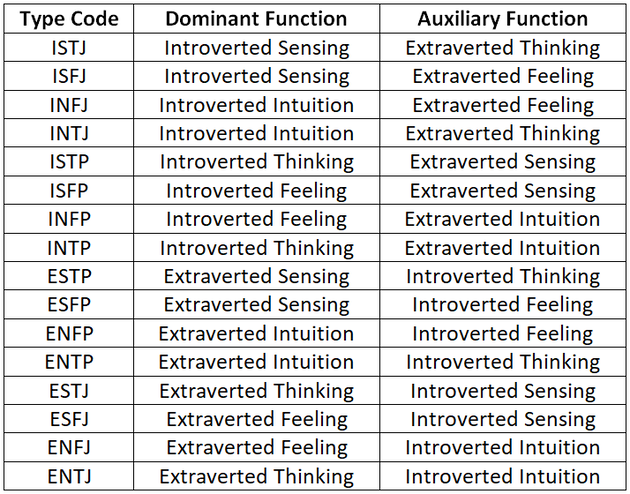|
Your Dominant Function, and Why It Matters
Copyright © 2019 by Thomas Piccin The Myers-Briggs model of personality type, rooted in the personality theories of Swiss psychiatrist Carl Jung first published in 1921, describes four “core” mental functions that we all employ: sensing and intuition, for taking in information from the external world; and thinking and feeling, for drawing conclusions and making decisions based on that information. The model proposes that although we all use all four functions at various times, we do not use them with equal ease or comfort (Myers et al., 2009). We each have a preferred perceiving function (sensing or intuition) and a preferred judging function (thinking or feeling). These preferences are represented by the two middle letters of the Myers-Briggs personality type code. For example, if your type code is ESTJ, then your favorite core functions are sensing (S) and thinking (T). Similarly, if your type code is INFP, then your favorite core functions are intuition (N) and feeling (F). Of these two favorite functions, one is your dominant function, your most trusted and best-developed function, and the other is your auxiliary function, which serves to balance and support the dominant function. Knowing your own dominant function is the first step in gaining the self-awareness that will help enhance your relationships and improve your learning, communication, and leadership skills. To identify your dominant function, we need to look at the other two letters in your type code. Jung believed that we all live in two worlds: our inner world of thoughts, ideas, and experiences, and the outer world of people, objects, and actions (Myers et al., 2009). The last letter in your type code indicates which of your preferred core functions you extravert, or direct to the outer world. If your last letter is J, then you extravert your favorite judging function (either thinking or feeling), and if it is P, then you extravert your preferred perceiving function (either sensing or intuition). The two functions balance each other, so if you extravert your judging function, then you introvert your perceiving function, and vice versa. For example, if your type code is INFP, the final P means you extravert your perceiving function, which is intuition (N), and therefore you introvert your judging function, which is feeling (F). The last step in determining your dominant function is to look at the first letter of your type code. If your first letter is E, then you have a general preference for extraversion, and therefore, whichever of your core functions you extravert is your dominant function. For example, if your type code is ENTJ, the final J tells us that you extravert your judging function, which is T. It then follows that you introvert your perceiving function, which is N. Furthermore, the initial E tells us that your dominant function is extraverted. Therefore, your dominant function is extraverted thinking and your auxiliary function is introverted intuition. Let’s look at one more example. Suppose your type code is INFP. Which of your core functions do you extravert? The P indicates you extravert your perceiving function, which is N (intuition). Therefore you must introvert your other core function, F (feeling). The initial I says you prefer introversion, so your dominant function will be your introverted core function, which in this case is F. Conclusion: Your dominant function is introverted feeling, supported by your auxiliary function, extraverted intuition. By the way, if all this is a little too much, you can just refer to the table below. Now that you know how to determine your dominant function, let’s talk about why it matters. First, your dominant function is the driving force of your personality. It is your “go to” function, the one you trust the most and use most often (Kirby et al., 2011). It is also the function you are most likely to rely on when you’re under stress. For example, let’s say your dominant function is extraverted sensing. You are most comfortable in your outer world, interacting with people and things, and dealing with tangible, practical realities in the present moment. Under stress, these tendencies will be amplified, to the point where you may even overlook the bigger picture and the broader impact of what’s happening right now.
The more attuned you are to your dominant function, the better equipped you will be to understand your own thought processes and responses, and to modulate those responses when necessary, making different choices instead of always relying on your old standby approach. Another reason it’s important to be aware of your dominant function relates to something we have already mentioned. People who prefer extraversion direct their dominant function outwardly, and people who prefer introversion direct it inwardly. You never need to wonder what’s important to an extraverted person, because they broadcast it on all channels in all directions. However, an introverted person does their best thinking internally, so their values and motivations are not always apparent to others. That’s why it takes some effort to get to know an introverted person. Not because they’re antisocial, but because all their important stuff is happening on the inside. The Myers-Briggs model teaches us that although we all have the ability to use our minds in a variety of ways, we each have a certain approach to learning and reasoning that is most comfortable for us. In particular, we each have a dominant mental function, which we direct either inwardly or outwardly, that forms the core of our personality. Understanding this dominant function is the key to understanding ourselves within the Myers-Briggs framework. References
|
Header photo by Thomas Piccin. View of Cape Town, Signal Hill, Table Bay, and Robben Island from the top of Table Mountain, South Africa.
